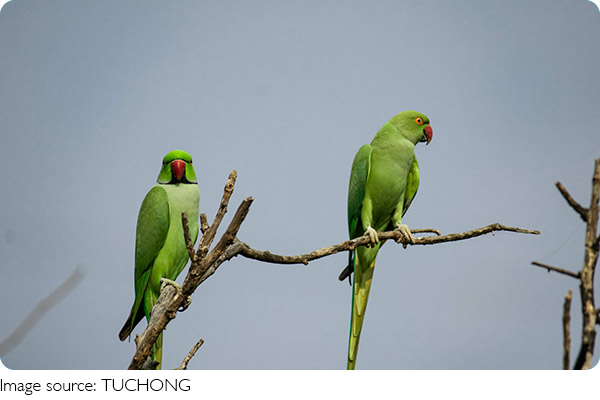Parrot Talking Genius

Let's be honest — the first time we hear a parrot say "hello" or mimic a laugh, we're totally amazed.
How can a bird sound just like us? It turns out, parrots aren't just repeating sounds for fun — they're showing off one of the most impressive talents in the animal world.
Let's explore how these colorful birds learn to “speak” and what it really means when they talk.
Why Parrots Can Talk
Unlike most birds, parrots have a special vocal structure called the syrinx. This is located deep in their chest and works a bit like our voice box. But what really makes parrots different is how well they can control their syrinx muscles — this allows them to produce a wide range of sounds, from squeaks to words that sound surprisingly human.
Even more interesting, parrots also have strong brains. Their brain structure includes an area called the core and shell song system, which is involved in learning and imitating sounds. This setup is similar to how humans learn languages. That's why parrots don't just make random noises — they actually learn from what they hear.
They're Not Just Copying
Some people think parrots are just echo machines, but that's not the full story. When parrots live with humans, they don't just repeat words — they often use them at the right times. For example, a parrot might say “good morning” when you enter the room or “bye-bye” when you leave. That shows they've connected those sounds with certain actions or times of day.
Some species, like the African Grey Parrot, are especially good at this. One famous parrot named Alex could name objects, answer questions, and even express feelings like frustration or happiness. That tells us these birds might understand more than we ever thought.
Learning Through Bonding
Parrots are naturally social. In the wild, they live in flocks and rely on sound to stay connected. When a parrot lives with humans, we become their flock — and talking is one way they try to bond with us. The more time we spend with them, the more words they learn. Just like children, they pick up speech by listening to the people around them.
And yes, they also copy tone and emotion. If you speak in a cheerful voice, they may repeat it in the same mood. That's why many parrots sound not just like humans, but like specific people — even down to their laugh or accent!
Practice Makes Perfect
Parrots don't learn words overnight. It takes regular exposure and practice. We've seen that the more a word is repeated clearly and often, the more likely the parrot is to learn it. Some parrot owners even train their birds with fun routines, like saying “treat” before giving food or “step up” when moving them to a perch.
And just like humans, each parrot has their own learning speed. Some may pick up words quickly, while others prefer whistles or simple sounds. That's totally normal — the key is patience, consistency, and interaction.

They Use Talking as a Tool
Parrots use speech as part of their daily life, not just as a trick. They might call out when they want attention or repeat a phrase they associate with fun. If a parrot says “peekaboo” every time someone walks by, it's not a coincidence — it's learned behavior tied to experience.
This ability to connect words with meaning shows just how smart these birds really are. They're not just mimicking — they're communicating in their own special way.
We're the Teachers
Since parrots learn from us, we need to be careful what we say around them! There are plenty of funny stories where parrots picked up words or phrases their owners didn't expect — and they never forget them. That's why creating a kind, encouraging environment is important if we want them to learn positively.
Let's Keep the Conversation Going
So Lykkers, the next time you hear a parrot speak, know that it's more than just a party trick — it's the result of brainpower, emotional bonding, and social smarts. These birds are clever, curious, and love to connect.
Have you ever heard a parrot say something surprising or funny? Or do you dream of teaching one to talk someday? Share your stories with us — let's keep the conversation alive, just like our feathered friends!
-
 Pet Vaccine GuideStill Skipping Pet Vaccines? Here’s Why Missing Even One Shot Could Put Your Furry Friend at Serious Risk!
Pet Vaccine GuideStill Skipping Pet Vaccines? Here’s Why Missing Even One Shot Could Put Your Furry Friend at Serious Risk! -
 Deer Lookalike GuideConfused by Deer? Here's How to Finally Tell Them Apart—With Photos and Fun Facts!
Deer Lookalike GuideConfused by Deer? Here's How to Finally Tell Them Apart—With Photos and Fun Facts! -
 Pet Budget HacksPet Costs Got You Stressed? Here's How I Save Big Without Compromising on Love or Care!
Pet Budget HacksPet Costs Got You Stressed? Here's How I Save Big Without Compromising on Love or Care!